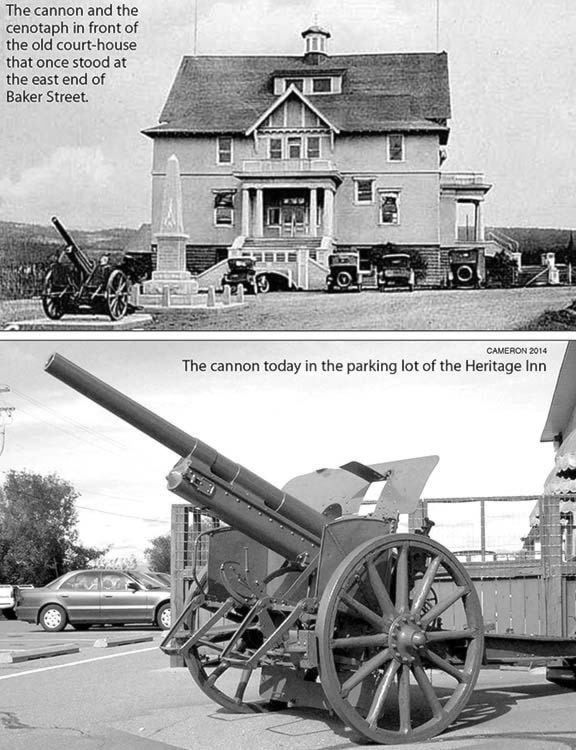Jim Cameron
A little World War One history, if you please: The period between August 8, 1918, to November 11, 1918, in terms of the First World War is, from the Allied (us) viewpoint generally called the "Hundred Days Offensive." From a Canadian viewpoint it is termed "Canada's Hundred Days," in reference to a series of attacks by the British First Army, of which the Canadian Corps played a substantial role.
The Canadians, including the 7th Canadian (1st British Columbia) Battalion, fought a number of important battles in France including those of Amiens, Arras, Cambrai, and Mons, where they were fighting on the final day of the war.
The Allied victories served to break the German Hindenburg Line of defense, (stretching approximately 150 km) and, thus forced the Germans to retreat from France completely, thereby bringing an end to the brutal, unwavering trench warfare to which both sides had been subjected for years.
The Canadian Corps entry into the French city of Cambrai and beyond, in early October, 1918, compelled the German High Command to accept that they could do little but surrender, which they did of course, on November 11, 1918.
Cranbrook boys were involved throughout the campaign in various regiments. In a letter to the Cranbrook Herald newspaper, written on October 14, 1918 (published Nov. 7) addressed to Mr. R.W. Edmundson of Cranbrook, James Lunn of the Mounted Rifles tells of being among the first to enter Cambrai.
"It was some scrap and from where we are lying now we can hear them going at it ... I sent you on a German belt which I got at Monchy: it will make a good razor strop: also a Fritzie [German] camouflaged helmet from Bourlon Wood. It is almost impossible to get a spiked helmet so I did the best I could. I hope they reach you; the helmet will make a good coal scuttle for Mrs. Edmundson ... I met Tom Marshall and Bobby Brewer the other day, also Bert Murgatroyd. They are all well ... Give all the boys my best wishes and I think I will soon be there to tell them the rest myself, as Fritzie is howling like hell now ... Remember me to Lester Clapp ... Tom Caven and Dave Spears, Balment and all the other boys."
Canada's Hundred Days saw the Canadian boys in some fierce battles. This period accounts for nearly 20 per cent of all Canadian casualties during the First World War.
Lunn also refers to the Bourlon Wood, which was part of a singular campaign that included a clever and complex night crossing of the Canal du Nord in France, by the Canadian Engineering Corps, who constructed the bridges allowing the Canadian troops to cross during the night, taking the German defenders completely by surprise the following morning.
The Germans were put into massive disarray and retreated so quickly that they left behind a great deal of weaponry, including ten field guns (cannons) captured by the 7th Battalion near Sains-les-Marquoin, possibly at the nearby hamlet of Haynecourt.
One of these, a German 7.7cm. Feldkanone 16 n.A., serial number: 19241, which, on August 7, 1920, arrived in Cranbrook, British Columbia, as part of the Federal Government allotment of captured German weapons shared across the country. Known commonly as a "77mm whizz bang", due to the sound of the shell in flight, it was formidable weapon on the battlefield. There is little doubt that this particular cannon and the others on the battlefield initially spelled destruction for the Canadian soldiers who finally silenced it.
To gain the enemies' guns was, and is, considered a very noteworthy feat and to lose them is a source of great humiliation.
There were a total of 398 large guns awarded across Canada, allotted according to the percentage of enlistments in each province and, then, according to the percentage of enlistments in each town or city. Ontario received 166; Quebec, 56; Manitoba, 45; British Columbia 35, and so on down the line to the Yukon, which received one. For a town the size of Cranbrook to receive such a trophy was a singular honour.
This year marked the 100th anniversary of the start of World War One. The captured German cannon has been on display in Cranbrook for almost a century, much of that time situated in a public place of honour. It appears that the Canadian Legion has been acting as caretaker of the gun on behalf of the City of Cranbrook for many years now.
The Legion has moved it to at least four different locations over the decades, the most recent being the rear parking lot of the Heritage Inn. When the gun was first received it came with a letter to the City of Cranbrook from Arthur G. Doughty, Dominion Archivist, which stated, in part: "These trophies, which have been declared the property of the people of Canada, are sent to you with the understanding that proper care will be taken of them and in taking them over, it is understood that you agree to this condition."
The Imperial Order of the Daughters of the Empire Memorial Fountain that graced Rotary Park for many years, created from funds donated by many of this community, now ignobly resides in the City Works yard. The captured German field gun sits in a parking lot.
As John McCrae so memorably put it:
...To you from failing hands we throw
The torch; be yours to hold it high.
If ye break faith with us who die
We shall not sleep, though poppies grow
In Flanders fields."
The words resonate meaningfully each year in the weeks leading up to the anniversary of the Armistice of the First World War on November 11. Perhaps, with Remembrance Day once again behind us, they are, for the rest of the year, nothing more than words from an old poem.
janusthenandnow@shaw.ca
